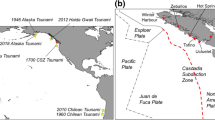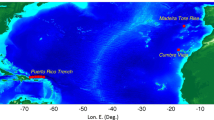Abstract
The Tagus estuary is bordered by the largest metropolitan area in Portugal, the Lisbon capital city council. It has suffered the impact of several major tsunamis in the past, as shown by a recent revision of the catalogue of tsunamis that struck the Portuguese coast over the past two millennia. Hence, the exposure of populations and infrastructure established along the riverfront comprises a critical concern for the civil protection services. The main objectives of this work are to determine critical inundation areas in Lisbon and to quantify the associated severity through a simple index derived from the local maximum of momentum flux per unit mass and width. The employed methodology is based on the mathematical modelling of a tsunami propagating along the estuary, resembling the one occurred on the 1 November of 1755 that followed the 8.5 Mw Great Lisbon Earthquake. The employed simulation tool was STAV-2D, a shallow-flow solver coupled with conservation equations for fine solid phases, and now featuring the novelty of discrete Lagrangian tracking of large debris. Different sets of initial conditions were studied, combining distinct tidal, atmospheric and fluvial scenarios, so that the civil protection services were provided with comprehensive information to devise public warning and alert systems and post-event mitigation intervention. For the most severe scenario, the obtained results have shown a maximum inundation extent of 1.29 km at the Alcântara valley and water depths reaching nearly 10 m across Lisbon’s riverfront.














Similar content being viewed by others
References
Alcrudo F, Benkhaldoun F (2001) Exact solutions to the Riemann problem of the shallow water equations with a bottom step. Comput Fluids 30:643671
Antunes CM (2007) Previso de Marés dos Portos Principais de Portugal. http://webpages.fc.ul.pt/~cmantunes/hidrografia/hidro_mares.html
Baptista MA, Miranda JM (2009) Revision of the Portuguese catalog of tsunamis. Nat Hazards Earth Syst Sci 9:2542
Baptista MA, Miranda JM, Omira R, Antunes C (2011) Potential inundation of Lisbon downtown by a 1755-like tsunami. Nat Hazards Earth Syst Sci 11:3319–3326
Canelas R, Murillo J, Ferreira RML (2013) 2DH modelling of dam-break flows over mobile beds. J Hydraul Res 51(4):392–407
Conde DAS (2012) A tsunami in Lisbon. Where to run? M.Sc. Thesis, Instituto Superior Técnico - Technical University of Lisbon
Conde DAS, Baptista MAV, Sousa Oliveira C, Ferreira RML (2013) A shallow-flow model for the propagation of tsunamis over complex geometries and mobile beds. Nat Hazards Earth Syst Sci 13(10):2533–2542
Ferreira RM, Franca MJ, Leal JG, Cardoso AH (2009) Mathematical modelling of shallow flows: closure models drawn from grain-scale mechanics of sediment transport and flow hydrodynamics. Can J Civ Eng 36:1604–1621
Jonkman S, Penning-Rowsell E (2008) Human instability in flood flows. J Am Water Resour As 44(5):1208–1218
Karvonen R, Hepojoki H, Huhta H, Louhio A (2000) The use of physical models in dam-break flood analysis: development of rescue actions based on dam-break flood analysis (RESCDAM) (final report). Helsinki University of Technology and Finnish Environment Institute
Leal JG, Ferreira RM, Cardoso AH (2006) Dam-break wave-front celerity. J Hydraul Eng 132(1):69–76
LeVeque R (2002) Finite volume methods for hyperbolic problems. Cambridge University Press, Cambridge
Luis JF (2007) Mirone: a multi-purpose tool for exploring grid data. Comput Geosci 33:31–41
Murillo J, García-Navarro P (2010) Weak solutions for partial differential equations with source terms: application to the shallow water equations. J Comput Phys 229(11):4327–4368
Omira R, Baptista MA, Matias L, Miranda JM, Catita C, Carrilho F, Toto E (2009) Design of a sea-level tsunami detection network for the Gulf of Cadiz. Nat Hazards Earth Syst Sci 9(4):1327–1338
Roberts SG, Nielsen OM, Jakeman J (2008) Simulation of tsunami and flash floods. Modeling, simulation and optimization of complex processes. Springer, Berlin
Synolakis CE, Bernard EN, Titov VV, Kânoglu U, González FI (2008) Validation and verification of tsunami numerical models. Pure Appl Geophys 165(11-12):2197–2228
Toro E (2001) Shock-capturing methods for free surface shallow flows. Wiley, New York
Yamazaki Y, Cheung KF, Kowalik Z (2011) Depth-integrated, non-hydrostatic model with grid nesting for tsunami generation, propagation, and runup. Int J Numer Meth Fluids 67(12):2081–2107
Yalin MS (1977) Mechanics of sediment transport, 2nd edn. Pergamon Press, Oxford
Acknowledgments
Project PTDC/ECM/117660/2010 and Doctoral Grant SFRH/BD/97933/2013, both funded by the Portuguese Foundation for Science and Technology (FCT), have partially supported this work.
Author information
Authors and Affiliations
Corresponding author
Rights and permissions
About this article
Cite this article
Conde, D.A.S., Telhado, M.J., Viana Baptista, M.A. et al. Severity and exposure associated with tsunami actions in urban waterfronts: the case of Lisbon, Portugal. Nat Hazards 79, 2125–2144 (2015). https://doi.org/10.1007/s11069-015-1951-z
Received:
Accepted:
Published:
Issue Date:
DOI: https://doi.org/10.1007/s11069-015-1951-z




